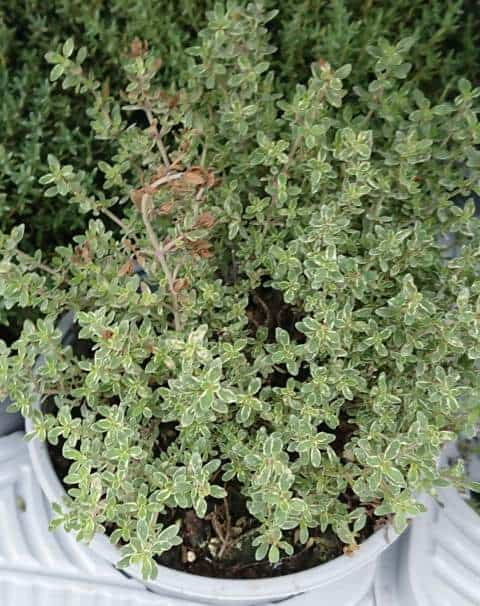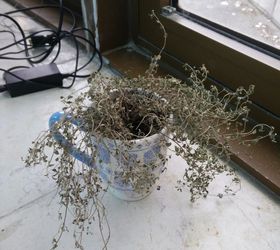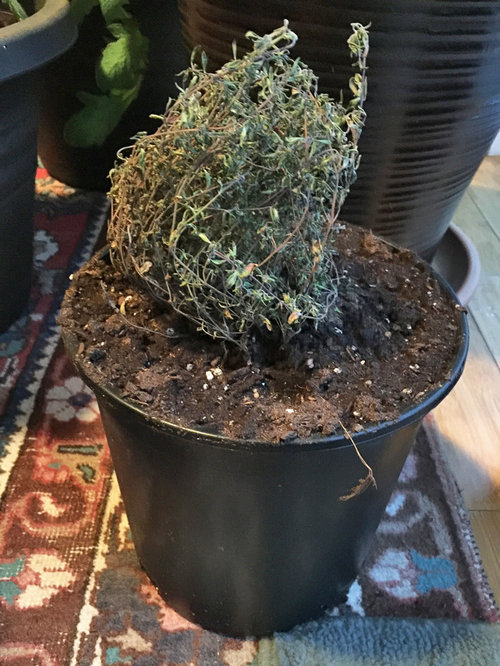
Thyme plants turn brown as a result of a fungus that is spread by too much moisture around the roots. Thyme is a Mediterranean herb that enjoys conditions that are relatively dry. Overwatering and poorly draining soils encourage the growth of the fungi that cause the browning of thyme plants.
Thyme, like many other Mediterranean herbs, is not a very long-lived plant, and it may naturally turn brown and die after 4 years even with careful care. This is another reason why thyme might become brown with age.
Although it is possible for thyme plants to go brown from a lack of water, this is uncommon because thyme is drought-resistant, favors dry environments, and often wilts rather than becoming brown.
Therefore, it is much more likely that overwatering, slow-draining soils, or pots without drainage holes are to blame for thyme becoming brown (sometimes with a drooping or withering appearance).
Humidity can sometimes cause thyme to turn brown, especially if they are planted too closely together.
Read on to find out why your thyme plants are turning brown and how to fix the issue.
Table of Contents
Thyme Turning Brown due to Moist Soil
Thyme plants are native to Europe’s Mediterranean region, where they thrive in full sun, sandy soils with good drainage, and infrequent rainfall.
Thyme is a drought-tolerant plant that prefers dry, full-sun environments and can suffer from overwatering and cold, wet soils, which is why it frequently goes brown in the winter.
The thyme can become brown as a symptom of stress from several fungal diseases such root rot which are more common in moist, cold soils if the plants are planted or maintained for outside of their typical relatively dry soil conditions.
Due to too much moisture around the roots, thyme can turn brown for three major reasons:
- excess watering Thyme is a perennial herb that has evolved to the dry, full-sun, low humidity, and infrequent rainfall of the Mediterranean environment. Since thyme is a drought-resistant plant, if you water it before the soil has had a chance to get only slightly moist (as opposed to constantly damp), you are overwatering it, which can make it turn brown.
- soils that drain slowly. The best thyme plants will grow on sandy soil similar to that found in the Mediterranean. Thyme prefers loose, well-draining soil with a high sand or grit content so that water may efficiently drain away from the roots after heavy rain or extended periods of irrigation.
- pots without base drainage holes. Thyme is frequently planted in pots or other containers without drainage holes in the base of the pot, which is a typical mistake. When excess water cannot drain, the soil gets soggy, which fosters root rot or other fungi that cause the thyme to become brown.
Save Thyme That is Turning Brown Due to Moist Soil

The most crucial actions to take to save a browning thyme plant are:
- Reduce watering to once a week or less. Between waterings, thyme loves the soil to become fairly dry. If there has been a lot of rain, don’t water until the soil feels completely dry to the touch. Although it may appear harsh, thyme plants actually thrive in dry environments like this! To ensure that the soil always has a chance to dry out rather than staying continually damp, adjust the frequency of your watering to the environment and conditions.
- If thyme is grown in soggy or slow-draining soil, transplant it. Thyme plants can turn brown due to a fungus that thrives in poorly draining soils with excessive moisture retention, such as clay soils. The best course of action is to move your thyme into a pot where you can manage the soil profile and make sure it is porous and well-draining. To ensure that the compost is porous and does not retain too much moisture, amend the potting mix with around 30% horticultural sand (or grit). This will reproduce the ideal circumstances for thyme plants in their natural environment.
- Make sure the thyme is in a pot that is big enough and has sufficient drainage. Because they are more porous than materials like plastic or metal and enable the soil to dry out more effectively, clay or terracotta pots are both suitable for growing thyme. Thyme should be planted in a pot with a minimum diameter of 12 inches, and the container’s base should have multiple drainage holes to allow any extra water to drain.
As fungal diseases can persist in the soil for years and potentially infect young plants, it is also advised to move the thyme (if it is noticeably turning brown) to a pot.
- Examine the roots before transplanting the thyme. Snip off the infected part of root to restore healthy growth if any of the roots appear to be discolored, mushy, or rotten.
- To avoid spreading the fungus to healthy areas of the plant, use sterile pruners and clean the blades with a cloth dipped in alcohol disinfectant after each snip.
- Trim back any brown stems and leaves to encourage healthy development, and burn or remove any infected growth (rather then place in a compost heap).
- Throw away the potting soil because it is the home of the fungus that is harming your thyme plant.
- Replant your thyme in fresh soil that contains roughly 70% multipurpose compost and 30% sand or grit for drainage improvement. The likelihood of recovery is increased since this ratio mimics the native well-draining soil conditions of thyme plants.
- If at all possible, provide the thyme plant with shelter from heavy rain and set the pot in direct sunlight. After two weeks, give the thyme a good bath at the roots with water that is enough to flow out the bottom of the pot.
- If your thyme plants are placed near garden borders, you should apply an organic fungicide to the soil to prevent the soil-dwelling fungi from infecting new plants.
The thyme plant can recover in a few weeks if you cut off all the sick plant tissue and put it in new soil (use multifunctional compost from the garden center as it does not host fungal illness). Make sure to plant it in full sun and water it no more than once per week.
Even though the plant can be brought back to health if you follow the instructions, it can be challenging if the plant is severely brown and sick.
Consider planting thyme in pots, containers, or raised beds to avoid them from turning brown due to water stress because they often have more favorable drainage than garden soil. Thyme plants grow quite well in pots or containers, as do all Mediterranean herbs.
High Humidity Causes Leaves to Turn Brown
To prevent thyme from turning brown, it’s crucial to mimic the low-humidity, arid areas where thyme plants thrive.
If thyme plants are grown too closely together, a humid microclimate may be created, which may favor the development of the disease Alternaria blight, which often affects the lower leaves and causes brown spots.
To prevent the fungus from spreading to the plant’s healthy sections, remove any affected leaves and make sure the pruners are disinfected with alcohol after each snip. The ill leaves and stems should be burned or discarded.
If you live in a humid environment, make sure to plant each thyme around 2-3 feet apart to allow for ventilation, which lowers the danger of disease.
Another excellent approach to improve ventilation and keep your plants disease-free is to put thyme in pots.
Thyme Turning Brown Because of Age

Even with proper care, thyme plants frequently start to turn brown after 4 or 5 years, at which point you may need to replace your plants.
Here is a YouTube video that demonstrates how simple it is to grow fresh thyme to replace your old plants:
Key Takeaways:
- Thyme plants develop brown leaves when the soil surrounding their roots is very damp. The likelihood of fungal diseases such root rot, which cause thyme leaves and stems to become brown as an indication of infection, is increased by wet soil.
- Overwatering, slow drainage, and pots and containers without adequate drainage holes in the base are common causes of the moist soils that foster the conditions for fungi diseases.
- Reduce watering and move thyme plants to a pot with well-draining soil to save plants that are starting to wilt. Any infected tissue should be removed to promote healthy growth. To stop the disease from spreading, wipe the pruner blades with alcohol disinfectant after each snip.
- To guarantee proper airflow, space thyme plants out by around 2-3 feet.
- Thyme can get brown with age because they typically only live for 4 to 5 years. To maintain a supply of plants with more leaves for cooking, thyme can be multiplied at a reasonable price.
